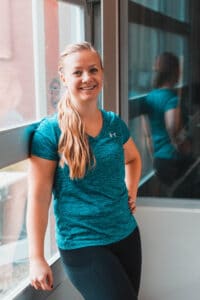In a world obsessed with smart technology, it’s hard not to ignore the constant pressure to track steps, count calories and measure sleep with the newest fitness technology. To some of us who like tracking stats this can be really fun! For some this can feel really intimidating. It’s hard to know if we need to really track everything or what to do with the data. What should our goals be? How do we set them? What makes us feel good? What feels overwhelming? These are conversations I have on a consistent basis with clients.
As a personal trainer, I pay attention to what my clients are talking about, what their struggles are, and try to help find solutions to those challenges. Since the pandemic began in March of 2020, I’ve witnessed a lack of movement and an increase in general chronic pain. When I say lack of movement, I’m not talking about workouts or classes or your peloton either. I’m talking about regular day-to-day movement. So many people underestimated how much movement they got just from dropping their kids at school, walking around the office and the grocery store and meeting friends out on the weekends. Being stuck in our homes working, grocery pick-up and limited social gatherings brought overall activity levels way down.
In addition to the mental fatigue and trauma from being isolated to our homes, I started to see people suffer from chronic pain. No amount of sit to stand desks or laps around the inside of your house make up for the general movement you once had in your day-to-day life. We’ve always known movement is good but now more than ever, I’ve witnessed the importance of intentional movement throughout your day.
How To Move More
I fully believe in science and research and using data to make recommendations for my clients and I still use that for my strength training recommendations daily. I also have learned a lot as a trainer by observing and recognizing patterns. At this point in time, I don’t have research backed data for my observations on lack of movement and increased chronic pain but if you can relate to one or both, here are some recommendations!
- Strength Training – Being strength professionals, we recommend strength training to increase blood flow and promote healing which can decrease pain.
- Steps – You don’t need to obsess over getting an exact step count but you should aim to move throughout the day. If you sit all day try moving before work, at lunch, and after.
- Stretch/Yoga – High stress levels can cause tension in the muscles. Spending some time stretching or practicing yoga can help reduce stress and tension which reduces pain
- Increase Heart Rate – You may be able to get your heart rate up with walking alone but most people can benefit from increasing their heart rate with cycling, running, dancing, etc. Find something you enjoy and move!
If I’ve learned anything over the last five years as a trainer, I’ve learned that everything has a season. In the training world we like to obsess over data and stats and build the perfect training program, but real life doesn’t always allow you to follow those programs perfectly. If you’ve read this and felt inspired to move more but don’t know where to start, pick one. You don’t have to do everything all at once. Start with strength training once per week, carve out 10 minutes a day to move outside, or try a new sport with your friends/family. If you need help getting started or trying something new, contact us for a Free Introductory Session! We’d love to help you set your next goal!
PS. Titanium Performance has an activity group on Strava! If you’re looking for a supportive community to get moving, join us!
Written By: Morgan (Maule) Maley



